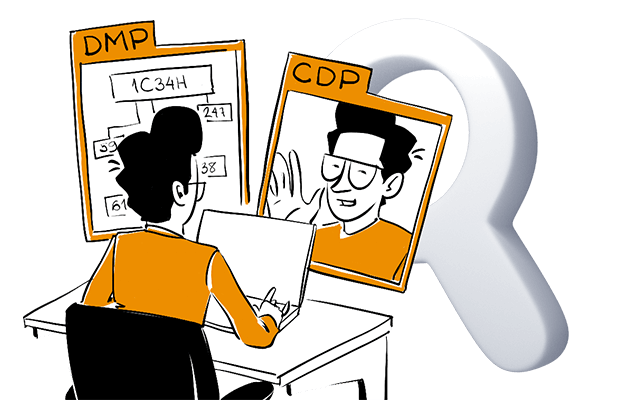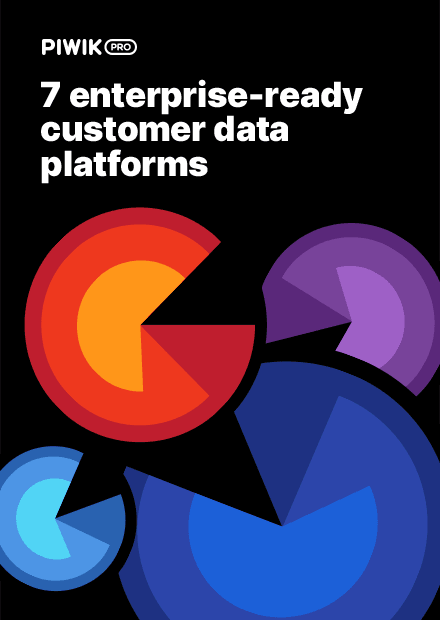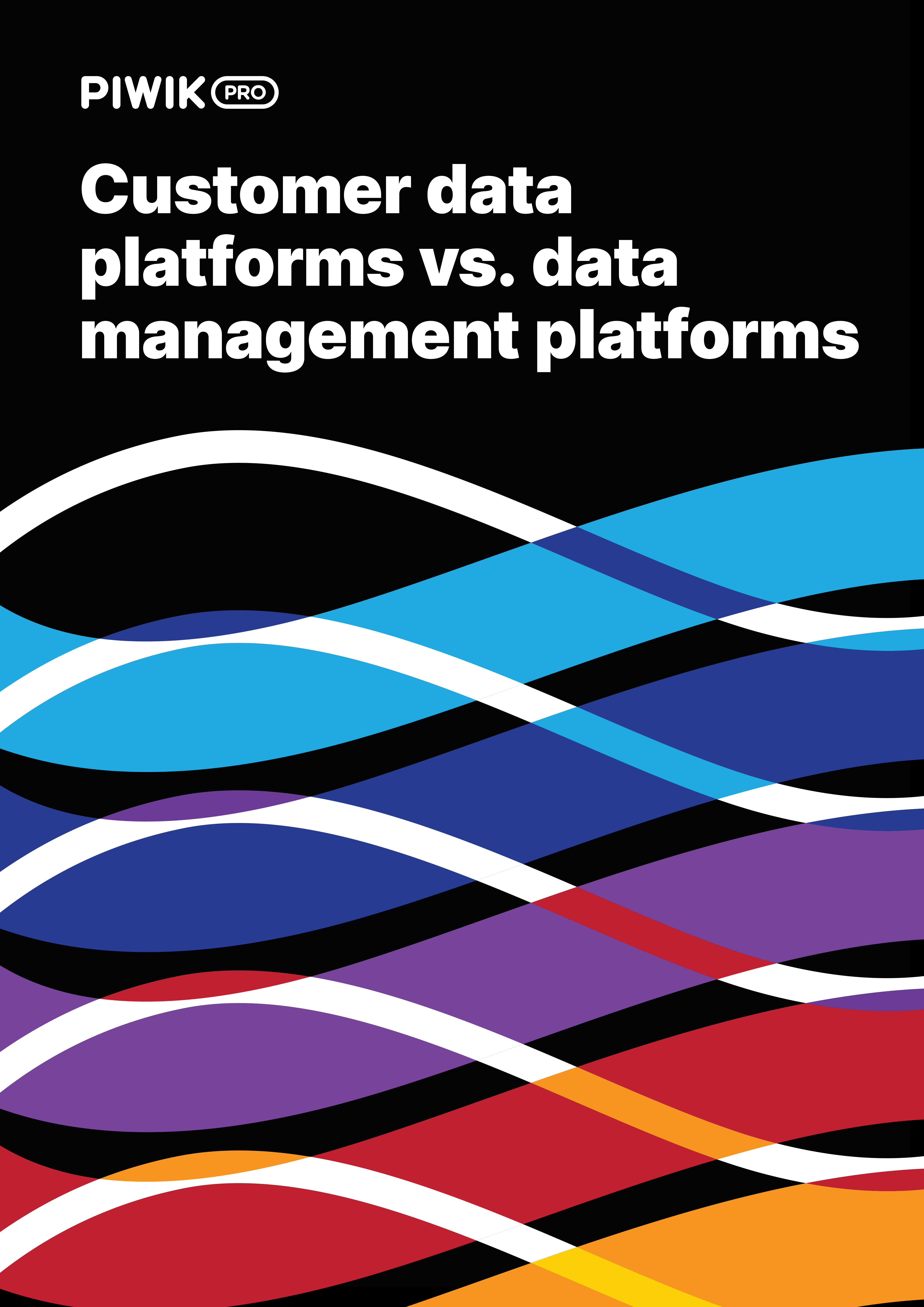Note: This article discusses customer data platforms in general. Piwik PRO’s CDP is now called Data Activation.
Data management platforms. Customer data platforms. Their names may sound similar, but are they the same? Let us guide you through the main differences between DMPs and CDPs.
For many years, data management platforms were the most useful tool in digital marketing and advertising. It was the first technology that allowed advertisers and marketers to collect, classify and house valuable information from multiple sources such as:
- Tags placed on websites and mobile apps
- APIs
- Server-to-server integrations
- Cookie syncing
- Third-party data sources
- First-party data onboarding
- And many more
This let advertisers and marketers use data to create detailed audience segments and send it to other platforms such as demand-side platforms (DSP) and side-supply platforms (SSP). Marketers could promote their products and services to audiences, i.e. segments of people who would be interested in them. Or they could sell the acquired information to a third party and benefit from a quick profit.
However, in 2013, David Raab, considered the father of this technology, coined the term “customer data platform”. Marketers gained a new way to manage data across the whole customer journey. CDPs became popular data management tools and turned out to be a great alternative to DMPs for many reasons that we’ll address later in the article.
We’ll present two platforms side by side to let you see how they can improve your business. They have some thematic overlaps. Both are helpful for marketers and are designed to provide customer insights. But they’re not the same thing.
Our goal is to help you understand the major features of these platforms and aid you in deciding which one is most suitable for your needs.
So, let’s dive in:
1. The purpose of DMPs and CDPs
The “why” behind creating certain data management software affects many aspects of how it works and what you can achieve by using it.
DMPs were originally designed for buy-side platforms, such as ad networks and demand-side platforms. A DMP collects user information from numerous sources, then classifies and categorizes it. It then puts the data into distinct segments and exports them to media-buying platforms, and further employs these segments to achieve certain goals, e.g. ad targeting. They also serve as data warehouses.
But DMPs are also valuable to publishers, to build audiences and sell them to advertisers, enhance engagement with personalized content and create new segments to extend their audiences.
If you want to dig deeper into the details of DMPs, read our posts:
CDPs, on the other hand, were primarily thought to be a system of records for managing customer data scattered across a company’s MarTech tools. The CDP gathers and unifies data from multiple online and offline sources, such as:
- Analytics data from your websites and apps
- CRM data
- Backend and/or transactional systems
Then it’s possible to use customer information across multiple communication and marketing channels, to personalize website content and emails, dedicated offers, and discounts.
CDPs help you improve conversion rates, customer retention and engagement with clients. Almost every department involved in dealing with customers uses CDPs. This includes marketers, store managers, manufacturers and many others.
In layman’s terms:
It’s safe to assume that a DMP is more of an AdTech platform, while a CDP is a MarTech tool. DMPs were designed primarily to target and retarget anonymous users visiting your websites. CDPs, in contrast, aim to create an exhaustive database about your customers that you can use in a variety of ways, not only for advertising.
2. Types of data DMPs and CDPs operate on
One of the most important differences between the two platforms is their approach to data anonymity and the types of data they use.
A quick reminder – what is first-, second- and third-party data?
First-party data
First-party data is the most valuable kind of information, since you obtain it directly from your users and customers. The direct relationship allows you to create user profiles based on the details of people interacting with your website and app.
This information comes from various sources, both online and offline, such as:
- An advertiser’s web and mobile analytics tools
- In-store visits
- Sales calls
- Customer relationship management (CRM) systems
- Transactional systems
- Data collected from subscription and newsletter sign-ups
- Other similar systems
Second-party data
Second-party data is basically first-party data that’s been collected directly by someone else. For instance, a car rental company might purchase an airline’s first-party data so they can target their passengers with car rental offers.
Third-party data
This kind of data comes from multiple sources, and you can buy it from third parties. It’s the least valuable type of data and raises many privacy concerns. However, marketers who don’t have access to first- or second-party data still use it to target their desired audience in online campaigns.
To learn more about different types of data, read our articles:
DMPs were created for advertising purposes, with data anonymity as one of their most important features. Because DMPs enable exchanging details about audiences between publishers and advertisers, they have to provide data anonymization to avoid privacy issues.
That’s why a DMP operates mostly on third-party data. It’s often stripped of common identifiers containing personally identifiable information (PII) or personal data. That makes it possible to share data between parties without putting anyone’s legal compliance at risk.
Still, as you work on third-party data it’s tricky to figure out the source of that information, and that might cost you quality. Also, it requires you to take additional steps to make sure you’re on the safe side of privacy regulations. We’ve covered that in this article.
Things look different in the case of CDPs. This technology works primarily on first-party data. You feed into CDPs data you have obtained directly from your customers and use it only for your own purposes. You don’t have to use hashing or remove details about known individuals, i.e. personal data.
The list of user details you’re allowed to use includes:
- names
- postal addresses
- email addresses
- phone numbers
As long as you handle it in compliance with privacy laws, you’re covered from the legal standpoint.
For more guidelines on processing and using this kind of information, read our article: What is PII, non-PII, and personal data? [UPDATED]
Keep in mind that both platforms digest all sorts of data. DMPs can work on first-party data, while CDPs employ information collected from third parties. In this article we present the most popular applications of these technologies.
3. How DMPs and CDPs approach building user profiles
User profiles are also differentiating factors between DMPs and CDPs.
In the case of a DMP, these profiles are temporary. They typically expire after 90 days, depending on the lifespan of a given cookie. The technology focuses more on segments and categories than user-level details. Since the data pushed into the platform is anonymous, most DMPs build segments and match data employing the probabilistic method.
The algorithm “guesses” the links between certain pieces of information. It doesn’t have access to known user identifiers that would allow it to determine if the data comes from one person. You can read more about it here.
However, DMPs use a predefined taxonomy, based on a stiff set of rules for data gathering, to profile customers into audiences. The data might be vague, lacking precise attributes to allow you to classify customers into the right audience.
With CDPs, the most common way to match users and customers together is through email addresses. Because a person’s email address is unique to them, the platform can identify and match users across a wide range of data sets. This is a deterministic matching method and gives greater accuracy, around 80-90%. Also, some larger DMPs employ this method.
This high accuracy allows CDPs to create an evolving database of profiles progressively enriched as people continue to engage with your brand.
A CDP collects and stitches user details across their user journey, allowing you to create single customer views – a 360-degree representation of all the aggregated information your organization knows about customers. It makes their profiles precise and permanent, as a CDP operates on granular data that doesn’t expire and is only subject to internal data retention policies.
For all the ins and outs of the single customer view, read our article: Single customer view: what is it and how does it work?
4. What you’re paying for
The service a DMP provides consists of combining your anonymous web analytics data with third-party data taken from various vendors. You’re paying for the ability to target prebuilt segments with your online ads and retargeting campaigns. What’s more, many DMP vendors charge you for every channel you activate your data on.
A CDP assists you in collecting and handling your customer information. It helps you make sense of all the disparate data coming from numerous places, build audience segments, and sync those audiences with every marketing tool in your stack. Also, it allows you to create a single customer view and track complete customer journeys, even in post-login areas. Many companies decide to invest in CDPs for precisely this reason.
Finally, with CDPs, no matter how many channels you use to put your data into action, you don’t have to pay anything extra.
To learn more about the features and benefits of customer data platforms, read our article: Customer data platform: What is it and how does it work?
Data management platforms vs. customer data platforms: a detailed comparison
Although data management platforms and customer data platforms (CDPs) have many things in common, a few factors make these data management tools very different.
We’re aware that this is a complex topic and that this post barely scratches the surface. That’s why we’ve created a dedicated comparison of CDPs and DMPs. From there, you’ll learn about over 25 characteristics of both pieces of software. We hope it will help you in deciding which better satisfies your business’ needs.














